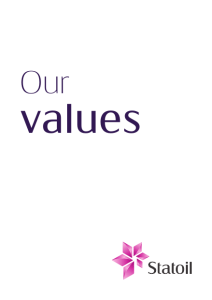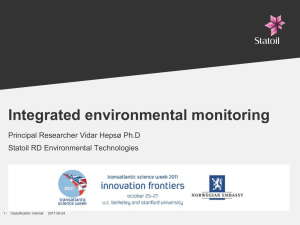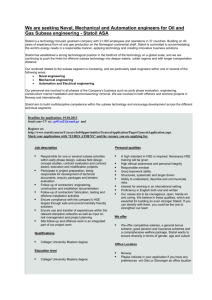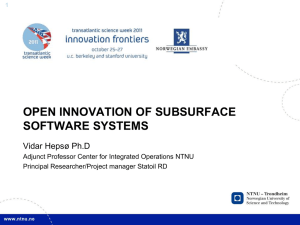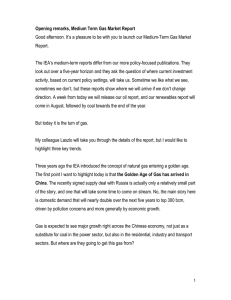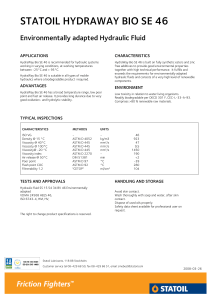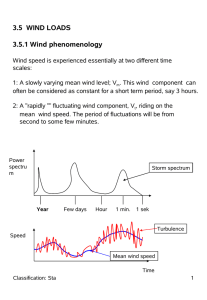Strategic Directions for Natural Gas
advertisement
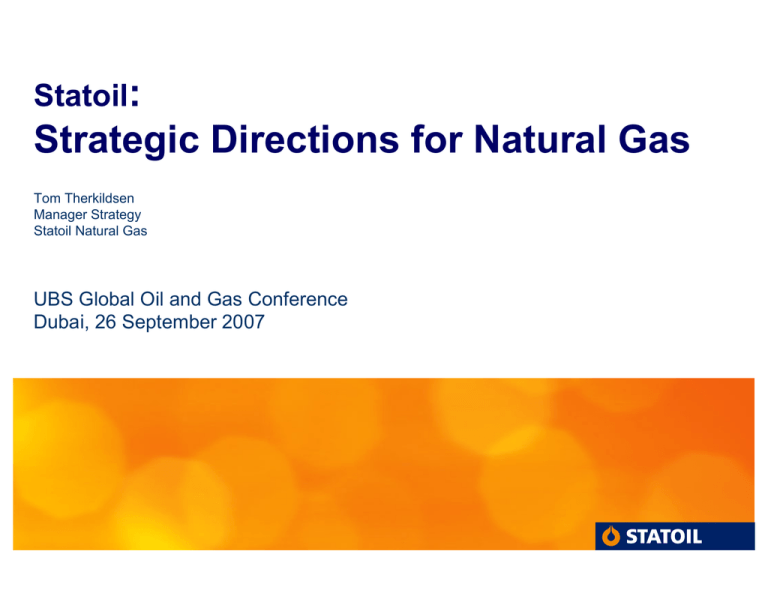
Statoil: Strategic Directions for Natural Gas Tom Therkildsen Manager Strategy Statoil Natural Gas UBS Global Oil and Gas Conference Dubai, 26 September 2007 2 Outline The case for natural gas Statoil’s position and strategy The Statoil/Hydro merger Concluding remarks 3 The case for natural gas 4 The future is fossil Coal, oil and gas will continue to be the main energy sources Power generation is the prime energy growth driver – 47 per cent of incremental demand towards 2030* *) IEA World Energy Outlook 2006 5 Human GHG emission trends 90 S2 80 27 Gt Gigatonnes 70 S1 60 50 40 550 ppm 450 ppm 30 20 10 0 1970 *) IPCC FAR, WG III, 2007. S1 and S2 are two of IPCC’s emission projection scenarios 2004 2030 6 What happens in a carbon constrained world? Cost of carbon to increase Costofofenergy energyuse to increase Cost to increase Renewableenergy energypursued pursued Renewable American gas Energy demand curbed Global gas Fuel mix to change 7 Replacing all coal with gas in EU25 power sector 800 700 600 Mt CO2 500 ~ 450 Mt reduction 400 300 200 100 0 Coal *) UNFCCC 2004, Statoil Gas 8 Future role of gas in European power Kyoto targets challenges; Spain - Italy Emission reduction potential from state-of-the-art coal plant LPDC and nuclear phase out in the UK Switching to gas from coal => huge emission benefits Additional reduction from shift to gas New diversified gas supply CO2 emissions from old coal plant Source: Deutsche Bank CO2 emissions from new CCGT 9 Natural gas may become tomorrow’s winner Heat Hydrogen Power Natural gas A low carbon future CCS Cogeneration Vehicle fuels 10 Statoil’s position and strategy 11 Norwegian Continental Shelf Extensive gas infrastructure Export capacity @ 120BCM/y by 2007 LNG capability from the Barents Sea Gas increasingly important 12 A major gas player in Europe Estimated market position in 20071 [total market size in BCM] ~ 20 per cent Markets two-thirds of all Norwegian gas sold in Europe Germany [90], France [50], Belgium [20], Ireland [5] 10-15 per cent Markets own gas and the Norwegian State’s gas Austria [10], Czech Rep [10], Netherlands [45] Meets around 12% of current1,2 consumption in Europe 5-10 per cent Spain [35], UK [110] Meets around 70% of current1,2 consumption of 0,86 BCM in Norway < 5 per cent Italy [80], Turkey [30] 1 Based on current contracts ; Statoil including SDFI 2 Status 2006 13 Building new international value chains The Snøhvit plant at Melkøya • • • • • Technology for an Arctic future Design capacity: 4,3 mt (5,75 BCM) per year No surface installations on the field CO2 storage beneath the seabed Start up 2007, Statoil share 33,5% Snøhvit LNG to USA and Europe • Annual export of 2,4 BCM to USA by ship • Current Statoil Cove Point terminal capacity 2,4 BCM per year, terminal located close to attractive markets • Cove Point expansion approved to increase terminal capacity to 10,1 BCM per year by 2008 • Annual export of 1,6 BCM to Spain by ship 14 Building new international value chains Algerian gas to Europe In Salah, Algeria’s 3rd largest gas development • Production start July 2004 • Statoil share 32 % (peak plateau 44 000 boepd) In Amenas, Algeria’s 4th largest gas development • Train I on stream June 2006 • Statoil share 50% (peak plateau 25 000 boepd) Caspian gas • Shah Deniz stage I deliveries though South Caucasus Pipeline (SCP) in 2006, Statoil share: 25,5% • Deliveries to Azerbaijan, Georgia and Turkey. 8,5 BCM per year • Shah Deniz stage II planned 2011 / 2012, capacity 8-12 BCM per year • Production capacity potential beyond Stage I and II 15 Statoil’s gas sales contracts Growth and diversification over 30 years Consortium Germany France New markets Italy Snøhvit LNG Czech Republic 2007 USA Belgium Netherlands Poland Spain • More than 25 Ireland 2007 1976 UK Additional Troll Scandinavia Shah Deniz Turkey Great Britain Spain Austria Norway Denmark Georgia Status 2006 Azerbaijan customers • End-user portfolio in UK • Short term sales • Gas trading in Europe and US 16 Our current strategic directions … Maximise value from long term business Focus and enhance portfolio optimisation Develop next generation gas business 17 The Statoil/Hydro merger LU 10 000 5 000 0 LU KO IL s ps tr ob ra hi lli ro n lY PF tr on as En i St at oi lH yd ro Pe oP Ch ev TO TA L Re ps o 15 000 Pe tr on as 20 000 Pe H yd ro i 25 000 R ep so lY PF S ta to il En TO TA L ps Sh el l BP on M ob il tr oC hi na Co no c Reserves, mmboe S he ll Pe tr ob ra s C he vr on Pe Ex x on M ob il ps tr ob ra hi lli lY PF l tr on as ps o Pe Re Lu ko i s St at oi lH yd ro Pe oP En i ta l ro n To Ch ev Sh el l BP tr oC hi na Co no c Pe Ex x 450 400 350 300 250 200 150 100 50 0 C on oc oP hi lli Source: Wood Mackenzie B P K O IL on M ob il 4 4 3 3 2 2 1 1 Pe tr oC hi na Ex x 18 StatoilHydro - Ranking Market value, bn USD Production (1000 boe/day) 500 000 500 000 500 000 500 000 500 0 2006 19 Strengthen the international competitiveness Arctic North Sea & Norwegian Sea Russia Canada Caspian USA North Africa Middle East South America West Africa Production 20 StatoilHydro’s natural gas business Largest gas player in Western Europe Markets more than 2/3 of Norway’s gas production Covers some 14 per cent of European demand Long term supply contracts Increasing value creation from trading business Extensive infrastructure ownership and operations Exposed to dynamic regulatory frameworks 10 locations: Algeria, Azerbaijan, Belgium, China, Germany, Singapore, Turkey, UK, US and Norway (Stavanger, Kårstø, Kollsnes) 21 Further growth Leveraging the NCS growth potential – Troll Further Development – The Norwegian Sea – Snøhvit II and the Barents Sea Growing positions in North-Africa and the Caspian Growing the US gas business LNG for the Atlantic Basin and Asia Expanding on short term optimisation Option for further downstream integration and commodity trading Improved mid-stream positions (storage, hub access, pipeline infrastructure) 22 Concluding remarks 23 Concluding remarks A major European gas supplier World class gas value chain operations Well positioned in marketing and trading Growth in international gas and LNG
